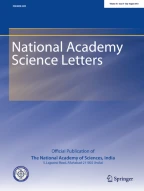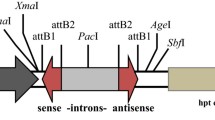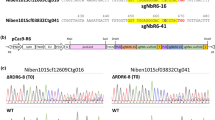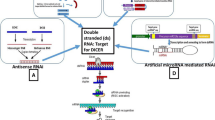RNAi (RNA Interference) Vectors for Functional Genomics Study in Plants

The discovery of RNA interference (RNAi) has revolutionized gene silencing for basic as well as applied studies. RNAi is a homology-dependent gene silencing mechanism, triggered by the introduction of double-stranded RNA (dsRNA) molecule. Since it can specifically suppress function of the targeted gene, the technique has been very useful in functional genomic studies. For efficient knock-down of the targeted gene, Gateway cloning based RNAi Silencing (pRISI) vector was developed. When a target gene-specific trigger fragment is cloned as inverted repeats in the pRISI vector, it produces a hairpin containing RNA transcribed from a CaMV35S (in case of pRISI-Ca) or from an ubiquitin (in case of pRISI-Ub) promoter. Function of the pRISI-Ca vector was confirmed by RNAi-mediated gene silencing experiment in Arabidopsis thaliana for At2g30350 gene which was found to be involved in repair of methylated DNA. A similar vector, pRISI-Ub was also developed for gene silencing studies in monocotyledonous plants. Its function was successfully demonstrated by transient suppression of GUS (UidA) gene co-bombarded with GUS-RNAi construct in wheat leaf. The vectors would be useful in rapid and easy preparation of RNAi constructs for reverse genetic studies for functional genomics in plants.
This is a preview of subscription content, log in via an institution to check access.
Access this article
Subscribe and save
Springer+ Basic
€32.70 /Month
- Get 10 units per month
- Download Article/Chapter or eBook
- 1 Unit = 1 Article or 1 Chapter
- Cancel anytime
Buy Now
Price includes VAT (France)
Instant access to the full article PDF.
Rent this article via DeepDyve
Similar content being viewed by others

Assessment of RNAi-induced silencing in banana (Musa spp.)
Article Open access 18 September 2014

CRISPR/Cas9-mediated knockout of the RDR6 gene in Nicotiana benthamiana for efficient transient expression of recombinant proteins
Article 07 May 2019

Post-transcriptional gene silencing: Basic concepts and applications
Article 15 October 2020
References
- Matzke M, Matzke AJM, Kooter JM (2001) RNA: guiding gene silencing. Science 293:1080–1083 ArticleGoogle Scholar
- Baulcombe D (2004) RNA silencing in plants. Nature 431:356–363 ArticleGoogle Scholar
- Meister G, Tuschl T (2004) Mechanisms of gene silencing by double-stranded RNA. Nature 431:343–349 ArticleGoogle Scholar
- Chen S, Hofius D, Sonnewald U, Bornke F (2003) Temporal and spatial control of gene silencing in transgenic plants by inducible expression of double-stranded RNA. Plant J 36:731–740 ArticleGoogle Scholar
- Lo C, Wang N, Lam E (2005) Inducible double-stranded RNA expression activates reversible transcript turnover and stable translational suppression of a target gene in transgenic tobacco. FEBS Lett 579:1498–1502 ArticleGoogle Scholar
- Waterhouse PM, Graham MW, Wang MB (1998) Virus resistance and gene silencing in plants can be induced by simultaneous expression of sense and antisense RNA. Proc Natl Acad Sci USA 95:13959–13964 ArticleGoogle Scholar
- Smith NA, Singh SP, Wang MB, Stoutjesdijk PA, Green AG, Waterhouse PM (2000) Total silencing by intron-spliced hairpin RNAs. Nature 407:319–320 ArticleGoogle Scholar
- Hamilton AJ, Brown S, Han YH, Ishizuka M, Lowe A, Solis AGA, Grierson D (1998) A transgene with repeated DNA causes high frequency post-transcriptional suppression of ACCoxidase gene expression in tomato. Plant J 15:737–746 ArticleGoogle Scholar
- Chuang CF, Meyerowitz EM (2000) Specific and heritable genetic interference by double-stranded RNA in Arabidopsis thaliana. Proc Natl Acad Sci USA 97:4985–4990 ArticleGoogle Scholar
- Wesley SV, Helliwell CA, Smith NA, Wang MB, Rouse DT, Liu Q, Gooding PS, Singh SP, Abbott D, Stoutjesdijk PA, Robinson SP, Gleave AP, Green AG, Waterhouse PM (2001) Construct design for efficient, effective and high-throughput gene silencing in plants. Plant J 27:581–590 ArticleGoogle Scholar
- Schweizer P, Pokorny J, Abderhalden O, Dudler R (1999) A transient assay system for the functional assessment of defence-related genes in wheat. Mol Plant-Microbe Interact 12:647–654 ArticleGoogle Scholar
- Kumar S, Arul L, Talwar D, Raina SK (2006) PCR amplification of minimal gene expression cassettes: an alternative, low cost and easy approach to ‘clean DNA’ transformation. Curr Sci 91:930–934 Google Scholar
- Nakagawa T, Kurose T, Hino T, Tanaka K, Kawamukai M, Niwa Y, Toyyoka K, Matsuoka K, Jimbo T, Kimura T (2007) Development of series of Gateway binary vectors, pGWBs, for realizing efficient construction of fusion genes for plant transformation. J Biosci Bioengg 104:34–41 ArticleGoogle Scholar
- Schweizer P, Pokorny J, Schulze-Lefert P, Dudler R (2000) Double-stranded RNA interferes with gene function at the single-cell level in cereals. Plant J 24:895–903 ArticleGoogle Scholar
- Kumar S, Bhat V (2012) High-frequency direct plant regeneration via multiple shoot induction in the apomictic forage grass Cenchrus ciliaris L. In Vitro Cell Dev Biol-Plant 48:241–248 ArticleGoogle Scholar
- Kumar S (2011) Biotechnological advancements in alfalfa improvement. J Appl Genetics 52:11–124 ArticleGoogle Scholar
- Kumar S, Chandra A (2010) In vitro plant regeneration in Stylosanthes spp via callus induction from cotyledonary and hypocotyl explants. Natl Acad Sci Lett 33:289–297 Google Scholar
Acknowledgments
SK acknowledges IUSSTF Research Fellowship (Ref # IUSSTF Fellowships/2009/14-SureshKumar) from the Indo-US Science and Technology Forum, New Delhi.
Author information
Authors and Affiliations
- Division of Crop Improvement, Indian Grassland and Fodder Research Institute, Jhansi, 284003, India Suresh Kumar
- Division of Biochemistry, Indian Agricultural Research Institute, Pusa Campus, New Delhi, 110012, India Suresh Kumar
- Suresh Kumar




